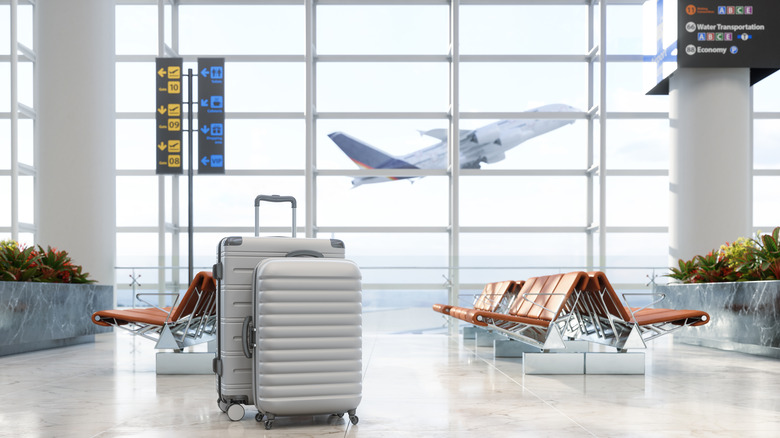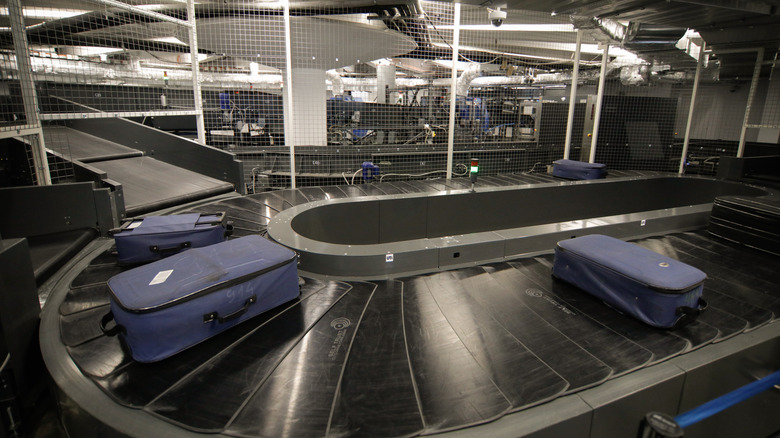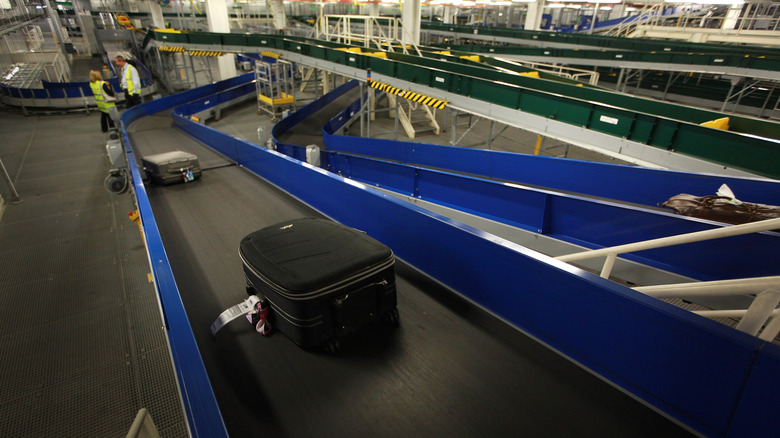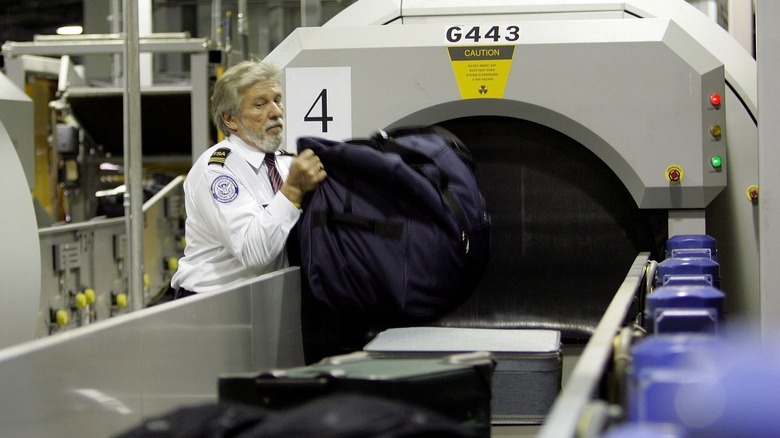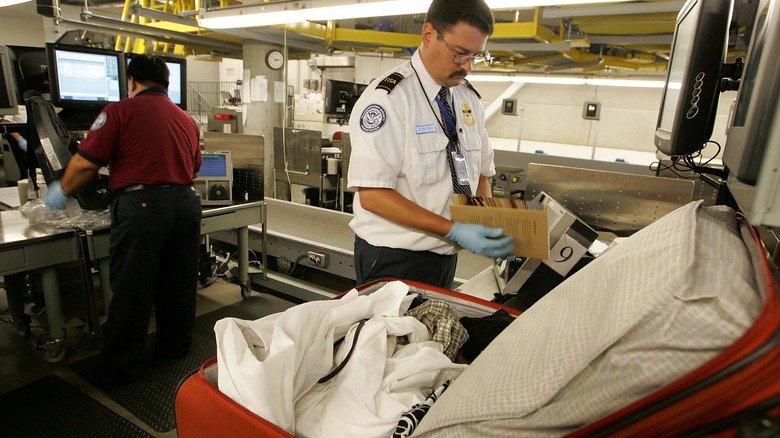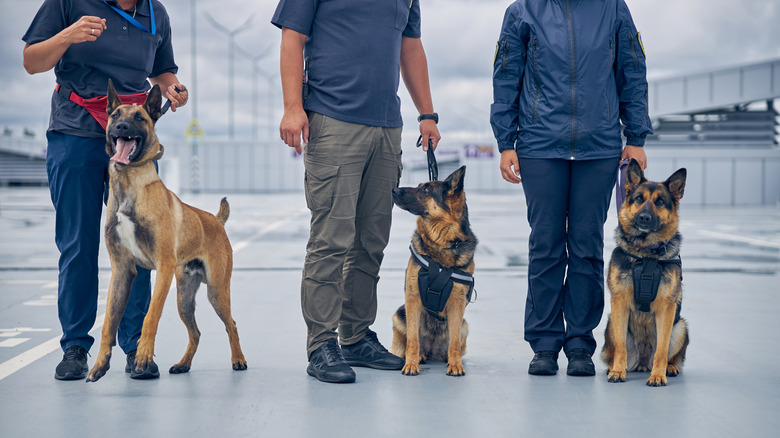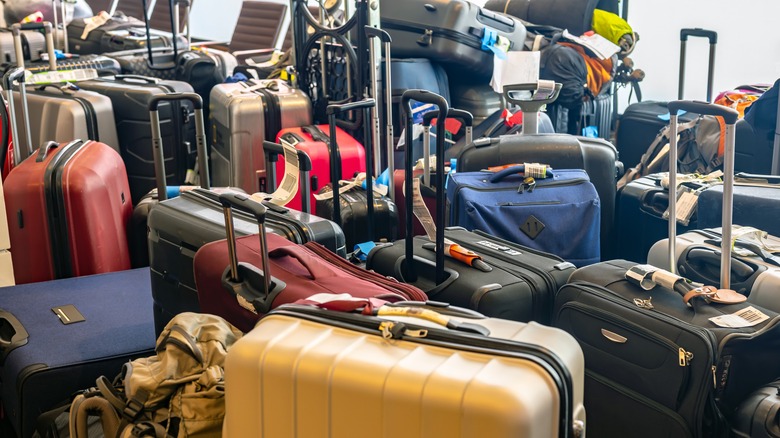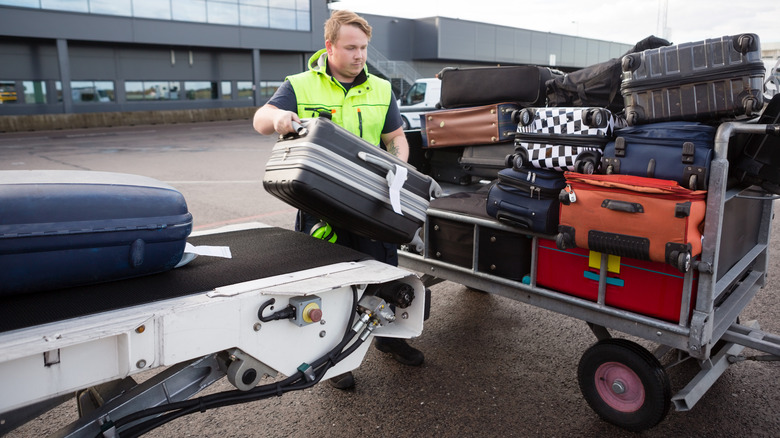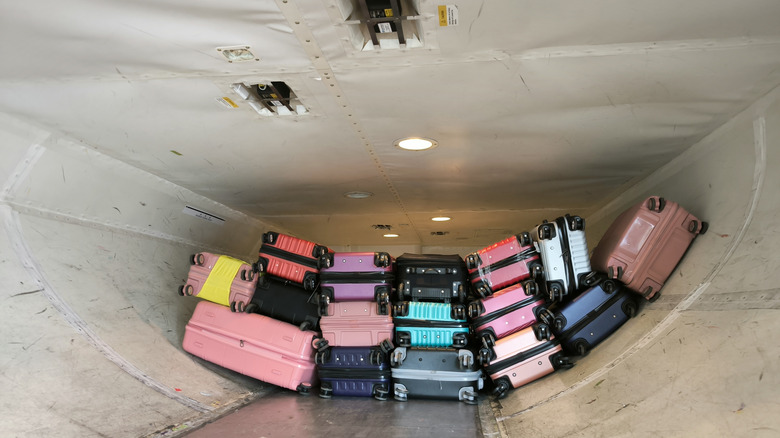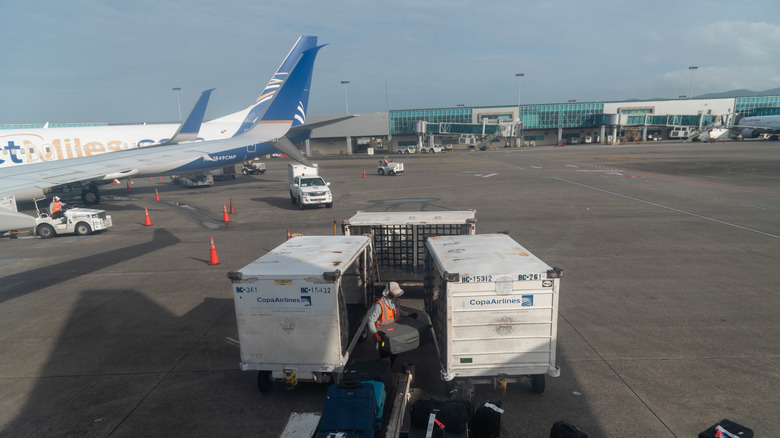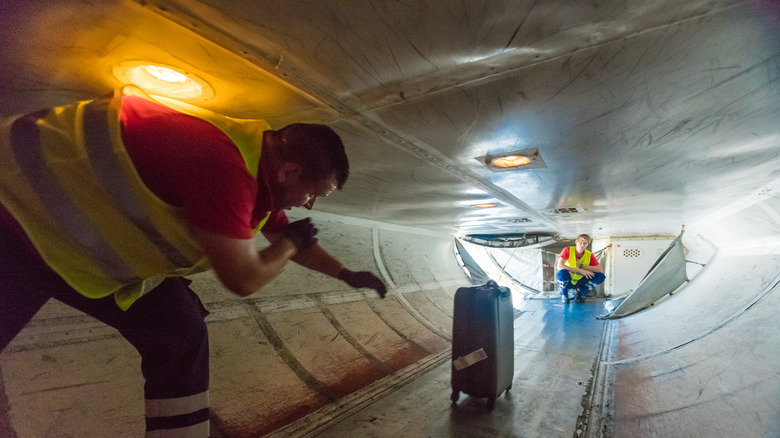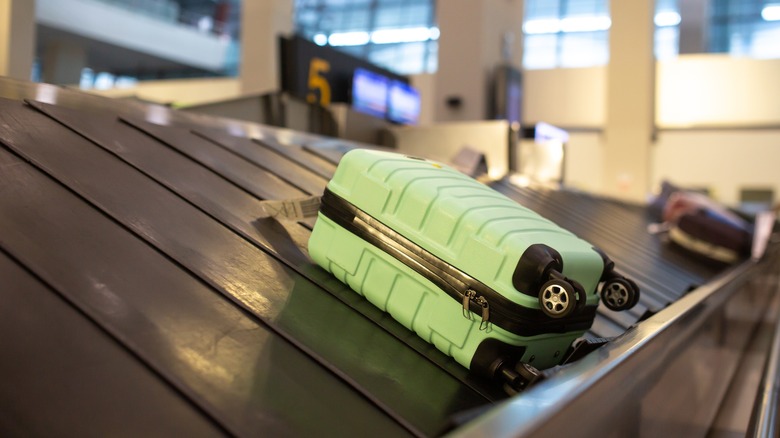Things Airlines Do To Your Luggage After It Gets Checked
Flying is stressful enough without taking care of your luggage. Thankfully, that's the airline's job. From the second it's weighed, tagged, and transported behind the curtain at check-in to the moment you spot your bag on the luggage carousel, your suitcase is on its own mini adventure under the watchful eye of the airline.
Unless you're a TSA agent or a baggage handler, most of us will never get to see this journey with our own eyes. Left to the imagination, we all picture it as something similar to the finale of "Toy Story 2," with highways of high-speed conveyor belts layered behind the check-in desks (only, you know, without the animated toys jumping from bag to bag). While this isn't totally inaccurate — there are, in fact, miles of conveyor belts back there — the reality is a little more complex. If you've ever wondered what happens to your suitcase once it's in the airline's care, here's a full breakdown.
Bags go through the sorting office
That barcode the airline pops on your suitcase serves one very good purpose. This code can track where your suitcase is, where it needs to go, and what time it needs to get there. So, if everything goes to plan, it will be waiting for you at your destination.
Once your luggage is checked in, this barcode is scanned by Automatic Tag Readers. These sort bags by airline, so they can navigate their way to the appropriate place within the airport. Scanners at checkpoints along the conveyor belts can normally catch barcodes on 90% of the suitcases, but if the bag is placed on the belt in such a way that the scanner can't find it, it'll be redirected for manual checks. Alternatively, some airports use RFID tags, which use radio-frequency electromagnetic fields to allow for even more accurate tracking.
From this point on, the airport will (hopefully) know where your bag is at all times. A range of diverters and pushers keep it on the right route — whether that's to a storage area if your flight isn't for a little while or to a destination-coded vehicle (DCV), which will ultimately take luggage to the plane.
It travels for miles and miles
There's a reason why airlines need those barcodes to keep track of your checked luggage. Your bag covers considerably more distance than you before it even reaches the plane, with even the smallest of airports boasting mind-boggling lengths of conveyor belts. The more extensive conveyor belts, such as those found at Miami International Airport (MIA), can span as long as 18 miles – which, for context, is even longer than the distance between the airport and the center of Miami Beach.
Of course, no bag is covering every last inch of these belts. A complex combination of software and the pushers we mentioned earlier are responsible for keeping thousands of suitcases and other pieces of cargo on the right path. With that in mind, it's impressive that bags go missing as infrequently as they do — in fact, less than 1% of luggage is mishandled each year. When bags do fall off or get stuck on the conveyor belts, sensors set off alarms to alert security staff. If luggage is lost, it's often because the barcode or RFID tag has become damaged, meaning the airport quite literally cannot track your bag anymore — meaning they're quite literally navigating miles and miles worth of conveyor belts blind.
Everything goes through a scanner
Next time you feel frustrated waiting in line at security, remember your checked luggage is going through the same thing (albeit without having to take off its shoes and belt). All suitcases are screened at a checkpoint using either an X-ray or a CTX machine — which combines an X-ray and a CT scanner — that creates a 3D picture of what's in your bag, primarily checking for items dense or oddly shaped enough to possibly be explosives.
These pictures are much more sophisticated than they used to be, meaning our luggage is being more thoroughly checked than ever. As Professor Nick Bowring previously told the BBC, "All the different materials are represented with different pseudo colors. Metal, for example, tends to come out blue; organic material tends to come out orange; lighter metals tend to come out green. That can be interpreted automatically by fairly advanced software which says this bag has maybe an undue amount of metal or organic material."
When the scanner decides something looks suspicious, it's usually anything but. One bag scanner previously described to Wired how items such as peanut butter, toothpaste, chocolate, golf balls, and even live crabs have been flagged in the past. Devices such as laptops, phones, and tablets also tend to confuse scanners, as they can't see through them. In total, it's thought CTX machines stop an estimated 18 to 35% of all checked bags, which are then subjected to further checks from TSA agents.
TSA may conduct a manual search
When your carry-on bag is flagged during security checks, the next step involves being taken aside as your bag is searched and, sometimes, swabbed for drugs. The same thing happens to any checked luggage raising alarm bells, with TSA agents conducting a thorough check to identify the item (or items) confusing the scanner.
The first step is opening the bag itself. If your suitcase bears a combination padlock — or any other kind of locking device — TSA will find a way in. Most of the time, this is with the aid of a universal master key. However, if the brand of your lock or suitcase isn't TSA-approved, the TSA does warn on its website that it will "be forced to remove these products if necessary during the inspection." In other words, your lock is toast.
Once the suitcase is open, TSA will rifle through your bag's contents to check for anything suspicious. Theoretically, you'll know if your bag was searched; by its own rules, TSA is supposed to place a notice of baggage inspection inside your bag to tell you that an officer went through your property. When their checks are complete, your bag will be reclosed and sent on its way (hopefully, with any locks reattached, although plenty of travelers have claimed their padlocks were removed for good).
Sniffer dogs pass by on a regular basis
Tempting though it is to pet dogs at the airport, these VIP canines have a job to do. Security dogs are typically split into two main categories: explosive-detecting dogs and drug-detecting dogs, both of which do regular passes by checked luggage.
The vast majority of sniffer dog work takes place in the line for security or around baggage claim. However, they will occasionally also inspect the checked luggage — especially if the airport has received a tip-off that one of the bags may contain something suspicious. These dogs aren't always accurate; past studies suggest that when it comes to sniffing out drugs in particular, they may be wrong as much as 88% of the time.
Checking for explosives is the working pup's main forte, with each dog trained to recognize the scent of chemical substances used to make bombs that human noses aren't strong enough to detect. Just how long we can expect sniffer dogs to be a part of this process is debatable. Humans aren't the only ones at risk of losing their jobs to AI, with biotechnology companies recently developing robots capable of identifying the same scents with far fewer false positives.
It may visit a suitcase hotel
If you're an über-paranoid traveler who likes to arrive at the airport and check in as early as humanly possible (in which case, join the club), odds are your plane is actually still en route, and there's nowhere for your bag to go just yet. In this case, your bag may be relegated to a temporary stop-off during its conveyor belt adventure: a suitcase hotel.
According to The Independent, this typically happens if there are 60 minutes or more to go before you board your flight. A "suitcase hotel" — also known as a baggage break-up area — is essentially just a storage area for your bag to wait until it can be taken to the next step in its journey. This may also happen if you've landed on a long layover outside the U.S. and you're traveling with the same airline (or one of its partners) on an inter-connecting flight, so there's no need to collect your luggage.
If your suitcase happens to get lost mid-journey, it will be taken somewhere similar. If the airport staff can't find a way to identify a suitcase, they'll keep it in storage at the same terminal where they were found for about five days before shipping it on to a central warehouse. If it's still not claimed from the warehouse within 60 days, the bag and its contents will often be donated to charity or auctioned.
It's driven to the plane
Impossible though it is to believe, there was once a time when passengers would take their suitcases to the plane themselves and then pick them up on the tarmac once their flight had landed. Obviously, those days are long gone, with our checked luggage now receiving its own chauffeur journey from the terminal.
Every suitcase destined for a plane will finish its conveyor belt journey in the same place. When it's time to load the plane, baggage handlers will transfer all of this luggage onto a cart, which will then be driven directly to the aircraft. In the future, this process may be totally human-free, with the Japanese airline ANA trialing a fully automated system utilizing "autonomous towing tractors" created by Toyota to get your bag from the airport to the plane. British Airways also experimented with driverless vehicles in 2019, with hopes to one day make the process even more streamlined.
Some flights — especially short-haul routes — may be on an extremely tight turnaround schedule, meaning they land and take off again in a surprisingly short space of time. For this reason, the plane isn't always loaded before you come aboard. If you're in a window seat, you may be able to spot baggage handlers in their iconic reflective gear making this drive and loading up the plane while everyone's still boarding.
Bags are stacked like Tetris
It's oddly satisfying to look at pictures of suitcases inside a plane. To maximize space and efficiency, suitcases are loaded in a very specific way to balance out the weight of the aircraft (although some airlines are reportedly stricter on this than others). That means that, no, the time you check in has absolutely zero impact on how quickly your suitcase will emerge at baggage claim — a rumor Delta Air Lines has previously also confirmed is false.
Transferred from the truck to the hold via a conveyor belt, luggage is manually stacked in a way that TikToker and Vancouver-based baggage handler Dj Sugue compares to the video game Tetris. Not only does this ensure every bag fits into the plane, but it also stops suitcases from moving around and disrupting the careful weight distribution (and coming out of the plane semi-destroyed). Some planes will have shelves and netting to help secure the bags into place, with bigger aircraft even boasting different sections in the hold to organize the bags properly.
Regardless of how the suitcases are arranged, those marked as "fragile" are usually loaded last (which means they're also usually the bags to hit the carousel first at baggage reclaim). Bags destined for another flight are also often some of the last to go on the plane to improve the chances of making their connection.
Some planes load bags into containers
Some planes — particularly bigger, widebody aircraft — won't load bags one by one. Instead, suitcases are stored in the plane's hold in containers. Think of these as the large-scale version of packing cubes. Not only do they make it quicker and easier to get the weight distribution right, but they also reduce the amount of effort and time needed by baggage handlers to unload and reload a plane between flights.
Bags are loaded into these containers before they make the journey to the aircraft. They're scanned before being loaded into a container, so the airline always knows which container contains which bags (making it much easier to remove a bag from the plane if a passenger fails to make their flight). The containers are typically made of aluminum and are known as Unit Load Devices (ULD). They're specially designed for aircraft and come in multiple sizes, with Simple Flying claiming that the most popular is common being the LD3, which can be used on all widebody Airbus planes and the Boeing 747, 777, and 787. This tends to be the same way planes load cargo, too. Just remember that someone's bag always has to be on the bottom of the container, so you may want to invest in a resilient suitcase if you're worried about your belongings being squished.
Air conditioning keeps everything cool
Have you ever picked up your suitcase at baggage claim and realized it feels cold to the touch — even if you've just landed in a tropical destination? There's a simple explanation for why this happens: the belly of the plane is pressurized and air-conditioned.
Conditioned air is redirected from the cabin itself, which makes the air colder as it reaches the hold. There's less concern about keeping things comfortable in the hold where there are no passengers, so it tends to be less insulated than the cabin. The final temperature can vary from plane to plane, but according to Air Canada, the Boeing 767 maintains an average above 7 degrees Celsius (44.6 degrees Fahrenheit). If you've checked an animal in with your suitcase, don't worry — they won't have to spend hours in the cold. Pets are instead kept in the bulk area, which has a less extreme minimum temperature of 18 degrees Celsius (64.4 degrees Fahrenheit).
A cable tie is (maybe) attached
The checks aren't over once the plane lands. Aviation security expert Martin Engeler told The U.S. Sun that all baggage is screened for a second time when it comes out of the airport. If this screening raises alarm bells, a fluorescent cable tie may be attached to the bag — something that can cause plenty of confusion when you pick your suitcase up at baggage claim.
If you notice a cable tie on your bag, it's because it has been flagged as needing a manual check at customs. Many of those who have experienced this in the past have claimed that this ended with the confiscation of items such as alcohol or electronics and even led to a hefty fine. "I got pulled up back in 2019, " News.com.au reported about one traveler from Australia who wrote in the Facebook group Bali Bogans. "Mine was green and they pulled me up and searched and charged me $300 AUD ... I was carrying Bluetooth speakers as gifts for my friends. They gave me option to leave at airport and pick up on way home."
This cable tie method is particularly popular in countries that are strict with what you can and cannot take past the border. Indonesia, for example, only allows 2.25 liters of alcohol and two cell phones per person. If you want to avoid any potential cable tie drama, we recommend always checking each country's restrictions before you travel.
